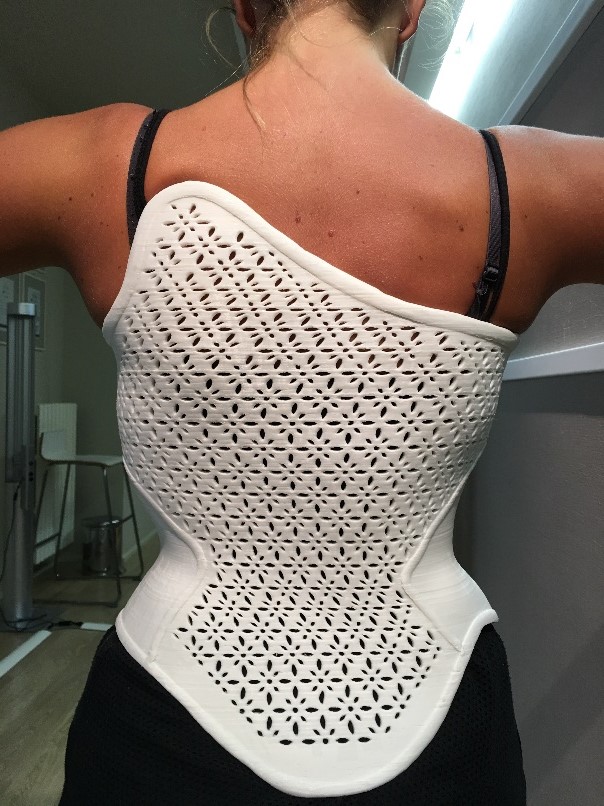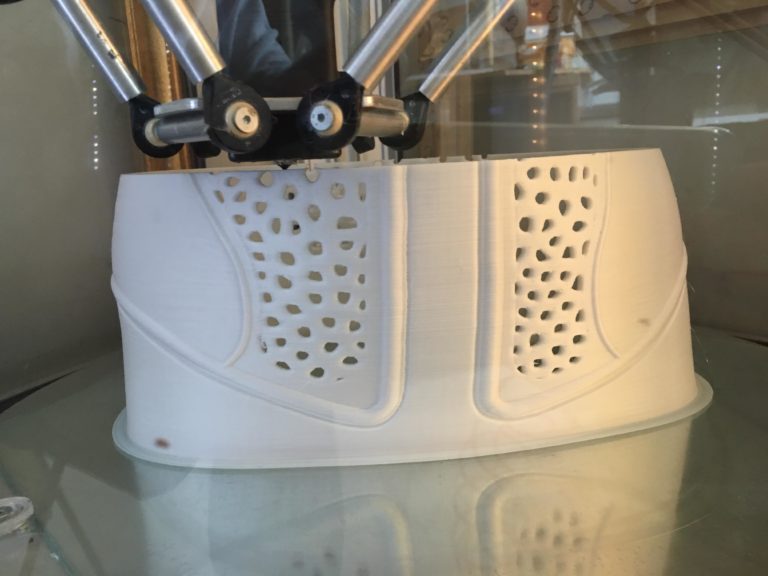Engineering students focus on scoliosis brace comfort, fit, design
Braces for people with scoliosis can be awkward, cumbersome and even painful. A good fit is crucial, especially since the brace is often worn day and night.

| Young girls that suffer from spinal curvature will soon be able to wear lighter and more stylish 3D-printed braces to treat their condition. The UNYQ Align is described as a “personalised, fashionable and breathable” back brace by its makers UNYQ. The Seattle- and Seville-based company, which specialises in orthopaedic and prosthetic products, worked with 3D-printing pioneer Francis Bitonti and technology company Intel on the product. Dezeen photo |

UNYQ Align 3D-printed back brace offers “fashionable” solution for scoliosis sufferers. Dezeen
University of Rhode Island via Science Daily November 2, 2016
KINGSTON, RI, Mechanical engineering students at the University of Rhode Island are collaborating with a local doctor and a Rhode Island company to create a brace that, well, fits like a glove – and is just as comfortable.
Gabriella Devine of East Greenwich, Thomas Brey of Manorville, NY, Dan Cross of Northborough, Mass., and Christopher Viveiros of Attleboro, Mass., are working on the project with a doctor from Rhode Island Hospital and SIMULIA, the Rhode Island branch of international computer graphics software company Dassault Systèmes.
The students are creating the brace for their senior design capstone class in mechanical engineering, which requires students to solve real-world problems with viable products. The students expect to have a prototype in April, after months of research.
“This project will have an impact on patients’ lives so it’s very rewarding for all of us,” says Devine. “It’s exciting to combine engineering skills and new technology.”
The project involves three fields: mechanical engineering; computer simulation; and medicine. To be competitive in today’s workforce, the students say it is crucial to get hands-on experience in fields outside their concentration and keep pace with cutting-edge technology.
Scoliosis is a curvature of the spine that usually occurs during puberty. There is no cure; however, it is treatable with a brace and, in extreme cases, surgery. Without treatment, the condition worsens and can be disabling.
There are two commonly used scoliosis braces: the Boston brace and the Providence brace, both of which could be improved, say the students.
The Boston brace, also called the underarm brace, is usually prescribed for curves in the lumbar or thoraco-lumbar part of the spine. It is typically worn most of the day under clothing and removed for gym class or sports. The Providence brace, also called a nighttime brace, is worn while sleeping.
“Because they’re bulky, sweaty and restrictive, kids – young girls especially – don’t want to wear them,” says Viveiros. “They feel self-conscious in public. We’re trying to make something a little more discreet — and breathable.”
Now, most doctors use padding to customize a standard brace for each patient. That technique has flaws, say the students. The process is time consuming for the patient and requires many medical visits to make sure the brace is fitting properly.
“This can be an inconvenience for teenagers,” says Viveiros. “And the brace itself can prevent kids from participating in activities that their classmates are doing.”

Using this new technique I have been able to achieve a very high level of precision, for example you can make amendments and revisions of the model, thing which would be impossible using the traditional and more common technique of the plaster cast. Lelio Leoncini, WASPmedical group
The URI students’ project involves the latest technology. The students will use a 3D scanner to get the patient’s precise body shape – “and that, we hope, will result in a brace that is completely personalized and form-fitting, yet still effective,” says Viveiros. Patients will also be required to get X-rays to determine the extent of the curve.
The students will use a 3D printer to make the brace, and the prototype will be made with plastic. “The plastic could come in different colors, so patients can chose their own color – sort of like braces for teeth,” says Viveiros. “We’re adding a little bit of fun to an otherwise difficult situation.”
In addition to SIMULIA, the students are also receiving guidance from Dr. Craig Eberson, chief of the division of pediatric orthopedics at Hasbro Children’s Hospital in Providence. They met with him not long ago to learn how scoliosis braces are fitted and what can be done to improve them.
At SIMULIA, the students are learning how to use engineering design software that makes the brace as effective as possible with the least amount of material. The new brace will have a lattice-like structure instead of a solid-shell, which requires more material.
“The software is smarter than a human,” says Cross. “It’s doing thousands of calculations in an instant, recognizing where the pressure needs to be on the brace to correct the curvature. This is the wave of the future in medical care – using software to solve health problems.”
The new brace could also be less expensive. Brey says that 3D printing is cheaper because less material and labor are involved. “Right now, 3D printing is pretty much used just to make prototypes. We’re trying to bring 3D printing into the mainstream to produce an actual product that meets industry standards.”
The students say they are thrilled to be working on a project that will improve lives.
“Our professors are devoted to us and want us to succeed,” says Viveiros. “This project is a great start to our professional careers.”
“Everything we’ve learned in the College of Engineering is being put to use,” says Brey. “The college is preparing us for an actual job. When we graduate we can be helpful to a company – and society.”
![]() Source University of Rhode Island via Science Daily
Source University of Rhode Island via Science Daily
| Green Sun Medical wins $225,000 to advance tech-enabled scoliosis brace |

| Green Sun Medical’s spinal brace for scoliosis patients allows physicians to monitor in real time corrective progress and use that information to make adjustments to the brace. Green Sun Medical Photo |
by Joshua Lindenstein, Biz West October 24, 2016
FORT COLLINS — Medical-device startup Green Sun Medical walked away from the MedTech Innovator competition’s top prize of $200,000 last week. But it was another award that came with a smaller $25,000 check that the company’s founders believe might end up having a bigger impact on the company.
In addition to the competition’s top prize, Johnson & Johnson officials awarded Fort Collins-based Green Sun a $25,000 scholarship to join the former’s JLabs incubator, which has multiple locations around the country. Green Sun CEO Jamie Haggard said Monday that the incubator membership, which could last up to two years, should allow his company to tap into invaluable industry expertise as it works toward going to market in the second half of next year with a tech-enabled spinal brace for adolescent scoliosis patients.
“Winning the MedTech Innovator was great for validation and showing we’re on the right track,” Haggard said. “And $200,000 is nothing to scoff at… the JLabs is almost more important.”
The MedTech Innovator competition finals were held during last week’s AdvaMed 2016, the major industry conference for the medical-device industry held in Minneapolis. Green Sun had been one of 430 initial applicants, a group that was whittled down to 20 semifinalists and eventually four finalists.
Founded in 2014, Green Sun Medical is based at the Innosphere incubator in Fort Collins. Green Sun’s brace goes beyond traditional scoliosis braces that are made of rigid plastic and are aimed primarily at preventing further curvature of the spine.
Continue reading in Biz West – Boulder Valley and Northern Colorado
| Dr. Lelio Leoncini and WASPmedical Create Better Spinal Care Through 3D Printing |
by Clare Scott, 3dprint.com November 11, 2016
When we talk about the accomplishments of the World’s Advanced Saving Project (WASP), we usually go immediately to the advancements they have made in construction. It’s hard to see past the fact that the organization is currently involved in 3D printing an entire village, after all, but WASP’s advancements in 3D printing go far beyond construction. For instance, they’ve done amazing things in the field of medical and assistive technology. The WASPmedical group holds the same philosophy as the rest of the company – that 3D printing can and should be used to meet people’s most basic and vital needs – housing, healthcare, etc. – for very little cost.

Lelio Leoncini, WASPmedical group
We recently discussed the many ways that 3D printing is improving the treatment of scoliosis, and a doctor named Lelio Leoncini has significantly contributed to those improvements. Dr. Leoncini, who specializes in physical medicine and physical therapy, is the Medical Director of the Sanatrix physical therapy and rehabilitation center in the Italian province of Potenza. He began experimenting with a DeltaWASP 40 70 3D printer to create orthopedic corsets for the treatment of scoliosis, and his research has led him to recently become part of the WASPmedical team.
“From an orthopedic and scientific point of view, the 3D printing allows to perform on scoliosis in a more efficient and effective way than the handmade production,” Dr. Leoncini said. “Through the virtual project, you find out how a scoliosis will develop; the production costs decrease considerably; you don’t have the problem to clear out the materials and you speed up production: a technician can hand-make a couple of corsets a day; using the 3D printing you can double the quantity and with a better quality. It is much more anatomical, it does not annoy the patient who, consequently, can wear it for a longer time; then allocating uniformly the loads, it acts in harmonic way then, last but not least, it looks nicer.”

Lelio Leoncini, WASPmedical group
According to Dr. Leoncini, the best way to treat scoliosis is a disputed topic with many schools of thought holding differing opinions about what is most effective. One thing that’s agreed upon, however, is that the traditional plaster-cast technique of creating scoliosis braces has to go.
“It is fundamental to overtake the plaster cast technique, and get a precise body-model realized with scanner – this allows to shape it in a very precise way, giving advantages not only to the operators but specially to the patients. Using this new technique I have been able to achieve a very high level of precision, for example you can make amendments and revisions of the model, thing which would be impossible using the traditional and more common technique of the plaster cast,” he explains.
Continue reading in 3dprint.com
| Further reading |
Effects of Bracing in Adolescents with Idiopathic Scoliosis, Weinstein SL, Dolan LA, Wright JG, Dobbs MB. N Engl J Med. 2013; 369 (16): 1512– 1521; doi: 10.1056/NEJMoa1307337 Epub 2013 Sep 19.
Also see
3D-printed back brace offers “fashionable” solution for scoliosis sufferers Dezeen
Monitoring scoliosis patients on brace use prevents curve progression, surgery Science Daily
Kids with Adolescent Idiopathic Scoliosis Motivated to Wear Brace Spine universe
NIH study establishes benefits of bracing in adolescents with idiopathic scoliosis National Institutes of Health
5 Surprising Facts About Adult Scoliosis Health Essentials
